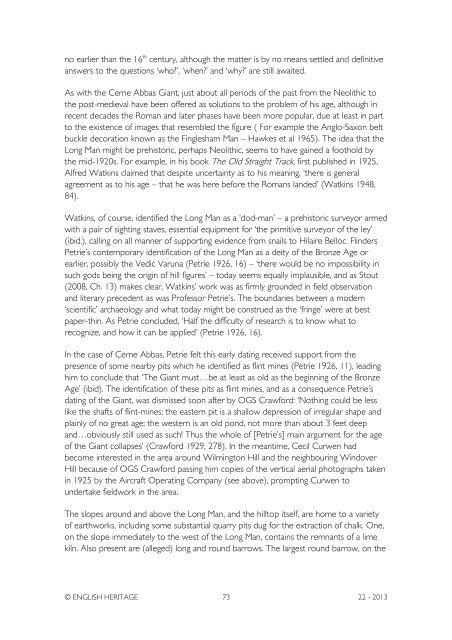Aerial Investigation and Mapping Report - English Heritage
Aerial Investigation and Mapping Report - English Heritage
Aerial Investigation and Mapping Report - English Heritage
Create successful ePaper yourself
Turn your PDF publications into a flip-book with our unique Google optimized e-Paper software.
no earlier than the 16 th century, although the matter is by no means settled <strong>and</strong> definitiveanswers to the questions ‘who?’, ‘when?’ <strong>and</strong> ‘why?’ are still awaited.As with the Cerne Abbas Giant, just about all periods of the past from the Neolithic tothe post-medieval have been offered as solutions to the problem of his age, although inrecent decades the Roman <strong>and</strong> later phases have been more popular, due at least in partto the existence of images that resembled the figure ( For example the Anglo-Saxon beltbuckle decoration known as the Finglesham Man – Hawkes et al 1965). The idea that theLong Man might be prehistoric, perhaps Neolithic, seems to have gained a foothold bythe mid-1920s. For example, in his book The Old Straight Track, first published in 1925,Alfred Watkins claimed that despite uncertainty as to his meaning, ‘there is generalagreement as to his age – that he was here before the Romans l<strong>and</strong>ed’ (Watkins 1948,84).Watkins, of course, identified the Long Man as a ‘dod-man’ – a prehistoric surveyor armedwith a pair of sighting staves, essential equipment for ‘the primitive surveyor of the ley’(ibid.), calling on all manner of supporting evidence from snails to Hilaire Belloc. FlindersPetrie’s contemporary identification of the Long Man as a deity of the Bronze Age orearlier, possibly the Vedic Varuna (Petrie 1926, 16) – ‘there would be no impossibility insuch gods being the origin of hill figures’ – today seems equally implausible, <strong>and</strong> as Stout(2008, Ch. 13) makes clear, Watkins’ work was as firmly grounded in field observation<strong>and</strong> literary precedent as was Professor Petrie’s. The boundaries between a modern‘scientific’ archaeology <strong>and</strong> what today might be construed as the ‘fringe’ were at bestpaper-thin. As Petrie concluded, ‘Half the difficulty of research is to know what torecognize, <strong>and</strong> how it can be applied’ (Petrie 1926, 16).In the case of Cerne Abbas, Petrie felt this early dating received support from thepresence of some nearby pits which he identified as flint mines (Petrie 1926, 11), leadinghim to conclude that ‘The Giant must…be at least as old as the beginning of the BronzeAge’ (ibid). The identification of these pits as flint mines, <strong>and</strong> as a consequence Petrie’sdating of the Giant, was dismissed soon after by OGS Crawford: ‘Nothing could be lesslike the shafts of flint-mines; the eastern pit is a shallow depression of irregular shape <strong>and</strong>plainly of no great age; the western is an old pond, not more than about 3 feet deep<strong>and</strong>…obviously still used as such! Thus the whole of [Petrie’s] main argument for the ageof the Giant collapses’ (Crawford 1929, 278). In the meantime, Cecil Curwen hadbecome interested in the area around Wilmington Hill <strong>and</strong> the neighbouring WindoverHill because of OGS Crawford passing him copies of the vertical aerial photographs takenin 1925 by the Aircraft Operating Company (see above), prompting Curwen toundertake fieldwork in the area.The slopes around <strong>and</strong> above the Long Man, <strong>and</strong> the hilltop itself, are home to a varietyof earthworks, including some substantial quarry pits dug for the extraction of chalk. One,on the slope immediately to the west of the Long Man, contains the remnants of a limekiln. Also present are (alleged) long <strong>and</strong> round barrows. The largest round barrow, on the© ENGLISH HERITAGE 73 22 - 2013

















